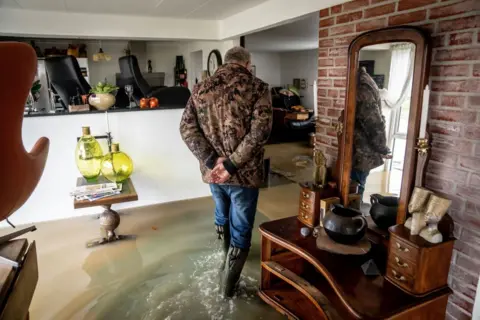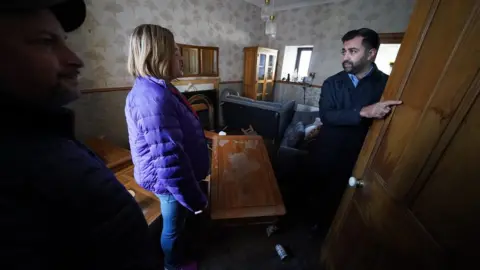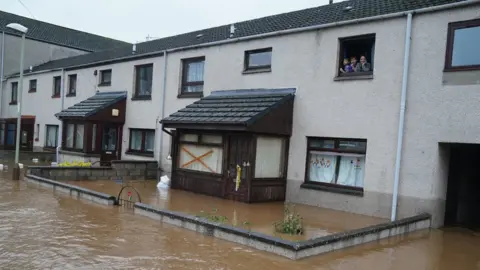Who pays the bills after the Storm Babet flooding?
 Getty Images
Getty ImagesThe costs of cleaning up after flooding can be enormous for both councils and individuals.
Previous storms are estimated to have cost the Scottish economy up to £700m, according to a report by accountants PwC.
But working out who pays for what and covering personal and business losses can be complex and demanding at a time when communities are dealing with the devastation that storms and floods bring.
Everyone involved in rebuilding from such events faces months of uncertainty and hard work to begin putting things back to normal.
The first minister has confirmed that the Scottish government has activated the Bellwin scheme, a discretionary fund which is designed to help councils that face extra costs as a result of large-scale emergencies.
Speaking as he toured flood-hit Brechin, Humza Yousaf said cash aid would be made available for the areas after councillors called for help.
 PA Media
PA MediaThe scheme has been activated a number of times in recent years including after storms Eva and Frank battered Scotland over Christmas and New Year 2015. Millions of pounds of aid was given to repair damage across the Borders and Aberdeenshire.
It was also used to help with disruption caused by the "Beast from the East" snow storm in February 2018.
Why was it called the Bellwin scheme?
The scheme is named after Irwin Bellwin, who served as a life peer in the Department of the Environment under Michael Heseltine in the first Thatcher government of 1979-1983.
The scheme compensates local councils which have been forced to incur extra expense to safeguard lives or properties.
However, it is not a blank cheque and only kicks in after councils have passed a "threshold" of spending.
The scheme expects local authorities to have set aside money for emergencies, money which they are expected to spend before applying for any help.
The amount available from central government is calculated across a full year, not just on one incident, and represents 0.2% of a local authority's budgeted net revenue expenditure.
In the case of the areas most affected by last week's floods, Angus council will have to pass a threshold of £573,240 for this financial year, while Aberdeenshire will only qualify after spending £1,262,730.
For people living in and running businesses in Brechin and other affected areas, the question now turns to how quickly they can get back into their properties and how they fund the costs of repairs and lost belongings or business assets.
Building and home contents insurance ought to take care of it, but this is time consuming and many people in flood areas struggle to find affordable cover.
In 2016 the UK government and some insurance companies set up Flood Re, which is designed to help people in such areas find affordable insurance.
 PA Media
PA MediaCarol Raeburn, director of the Scottish Flood Forum which was set up to aid communities affected by such events, said helping people with insurance claims is one of the first things they will do in the wake of the floods.
But speaking on BBC Radio's Good Morning Scotland programme, she said a major issue was people who were not insured at all.
"We are seeing that all too commonly across Scotland as a result of the cost-of-living crisis," she said.
"So we'll be helping direct householders to initiatives to help but also other welfare that can get them through this crisis," she added.
Ms Raeburn said the speed of getting people back into their properties depends on the level of damage from the flooding and also the availability of trades people and other suppliers.
"The whole of Scotland has not escaped flooding and in fact we at the forum are still responding to flooding from two weekends previously.
"It will be a question of getting people out to assess and work out the damage and the level of claims," she said.
She stressed the advice from insurers is to get in touch as soon as possible and get any claim underway even though they might not yet know the extent of the damage.
